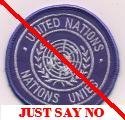Kyoto
by Nicholas Kralev, The Washington Times
The United States and five Asia-Pacific countries have concluded an agreement to deploy new technologies aimed at reducing greenhouse gas emissions as an alternative to the Kyoto Protocol on climate change, U.S. and Australian officials said yesterday.• This article is based in part on wire service reports
The legally nonbinding deal, to be signed by China, India, Japan, Australia and South Korea as well as the United States, goes beyond the 1997 Kyoto accord by limiting emissions from Asia's two rapidly developing giants -- China and India -- as well as by developed countries.
"Our focus has been and remains on promoting cost-effective, technology-based approaches to addressing climate change," State Department spokesman Sean McCormack said.
"We are pursuing these voluntary approaches both at home and abroad, through our bilateral climate-change partnerships and our multilateral science and technology partnerships," he said.
Australia will host the first meeting of the six nations in November, diplomatic sources said today at a regional Asian forum in Laos.
"We know that this is the answer," said Australian Environment Minister Ian Campbell. "We know that the Kyoto Protocol is a failure in terms of saving the climate. We have to do better."
He said the agreement, which was initiated by the United States, was a result of yearlong negotiations. President Bush discussed it with the prime ministers of Australia and India -- John Howard and Manmohan Singh -- during their visits to Washington last week, officials said.
"The main aim of effective action is to involve rapidly developing countries who have legitimate needs to increase their energy use, but we also need to find the answer to the global imperative of reducing emissions," Mr. Campbell said.
"That's going to need the development of new technologies and the deployment of them within developing countries," he told reporters in Canberra.
The new "partnership," as U.S. and Asian officials called it, will cover the fields of energy efficiency, clean coal, integrated gasification combined cycle, liquefied natural gas, carbon capture and storage, combined heat and power, methane capture and use, civilian nuclear power, bioenergy and other renewables.
The new agreement comes less than three weeks after comments by Mr. Bush at the Group of Eight summit in Scotland about an alternative to the Kyoto Protocol.
Calling the Asia-Pacific version a "new results-oriented partnership," Mr. Bush said yesterday that it will allow nations to "develop and accelerate deployment of cleaner, more efficient energy technologies to meet national pollution reduction, energy security and climate change concerns in ways that reduce poverty and promote economic development."
"The six Asia-Pacific partners will build on our strong history of common approaches and demonstrated cooperation on clean energy technologies," he said.
The United States and Australia are not among the 140 nations that have ratified the Kyoto Protocol, which imposes legally binding requirements on 35 industrialized countries to cut greenhouse gas emissions an average of 5 percent below 1990 levels.
Those targets, they say, would have a negative impact on the economy. But they insist that they are still committed to protecting the environment.
"Just because we have expressed our concerns about the Kyoto agreement does not mean that this president hasn't been at the forefront in pushing for technologies that would help -- not only U.S. companies but companies around the world -- deal with environmental issues, so that they are able to build more prosperous economies in a way that also has a positive effect for the environment," Mr. McCormack said.
Mr. Campbell said that Australia "only emits 1.4 percent of the world's greenhouse gases."
The United States, however, is the world's largest culprit, followed by China.
Deputy Secretary of State Robert B. Zoellick planned to announce the new pact, called the Asia-Pacific Partnership on Clean Development and Climate, at the annual meeting of the Association of Southeast Asian Nations in Vientiane, the capital of Laos today, but Australian officials leaked the news to the Australian newspaper.
The new arrangement was speedily condemned by environmental groups.
"Skulking around making secretive, selective deals will not accomplish this; signing up to the Kyoto Protocol will," said Greenpeace energy campaigner Catherine Fitzpatrick.
"A deal on climate change that doesn't limit pollution is the same as a peace plan that allows guns to be fired," said Jennifer Morgan, head of the climate-change program of the World Wildlife Fund, a conservation and environment advocacy group."
----------------------------------------------------------------
HeavyHanded is extremely happy that this President sees through the folly of the Kyoto Protocol and what is really behind the Kyoto agenda. My fear is long term. What will the next two or three presidential election cycles bring us?
UPDATE:
Heh, heh. Chrenkhoff blogs, "And the new pact has already achieved some global cooling:
A new American-led initiative to combat global warming met with a cool reaction yesterday as Europe and environmentalists warned that it risked undermining the Kyoto Protocol."
FAIR USE NOTICE: The above may be copyrighted material, and the use of it on Heavy-Handed Politics may not have been specifically authorized by the copyright owner. Such material is made available on a non-profit basis for educational and discussion purposes only. We believe this constitutes a 'fair use' of any such copyrighted material as provided for in 17 USC § 107. For more information go to: http://www.law.cornell.edu/uscode/17/107.shtml. If you wish to use copyrighted material from this site for purposes of your own that go beyond 'fair use', you must obtain permission from the copyright owner.



































0 Comments:
Post a Comment
<< Home